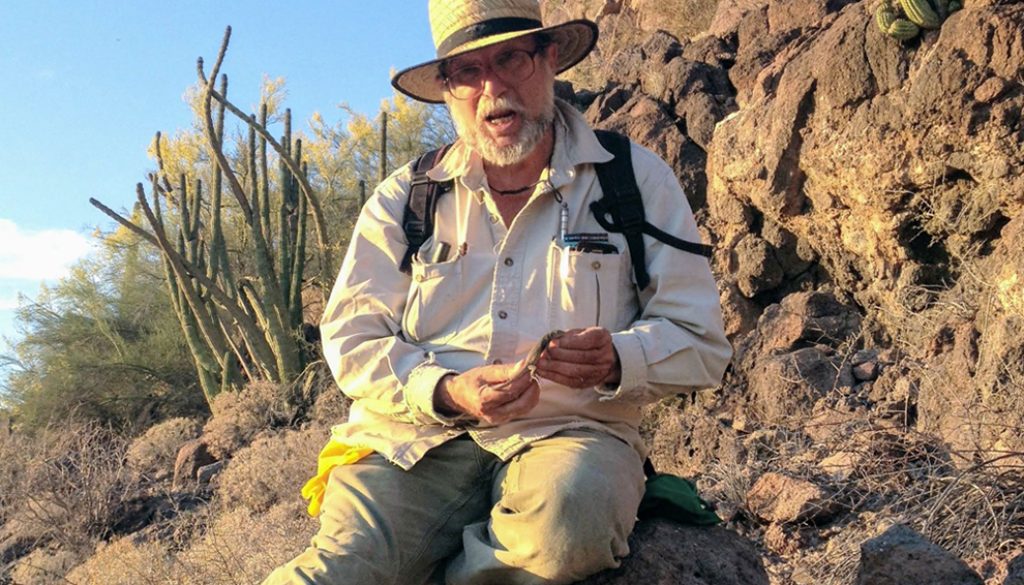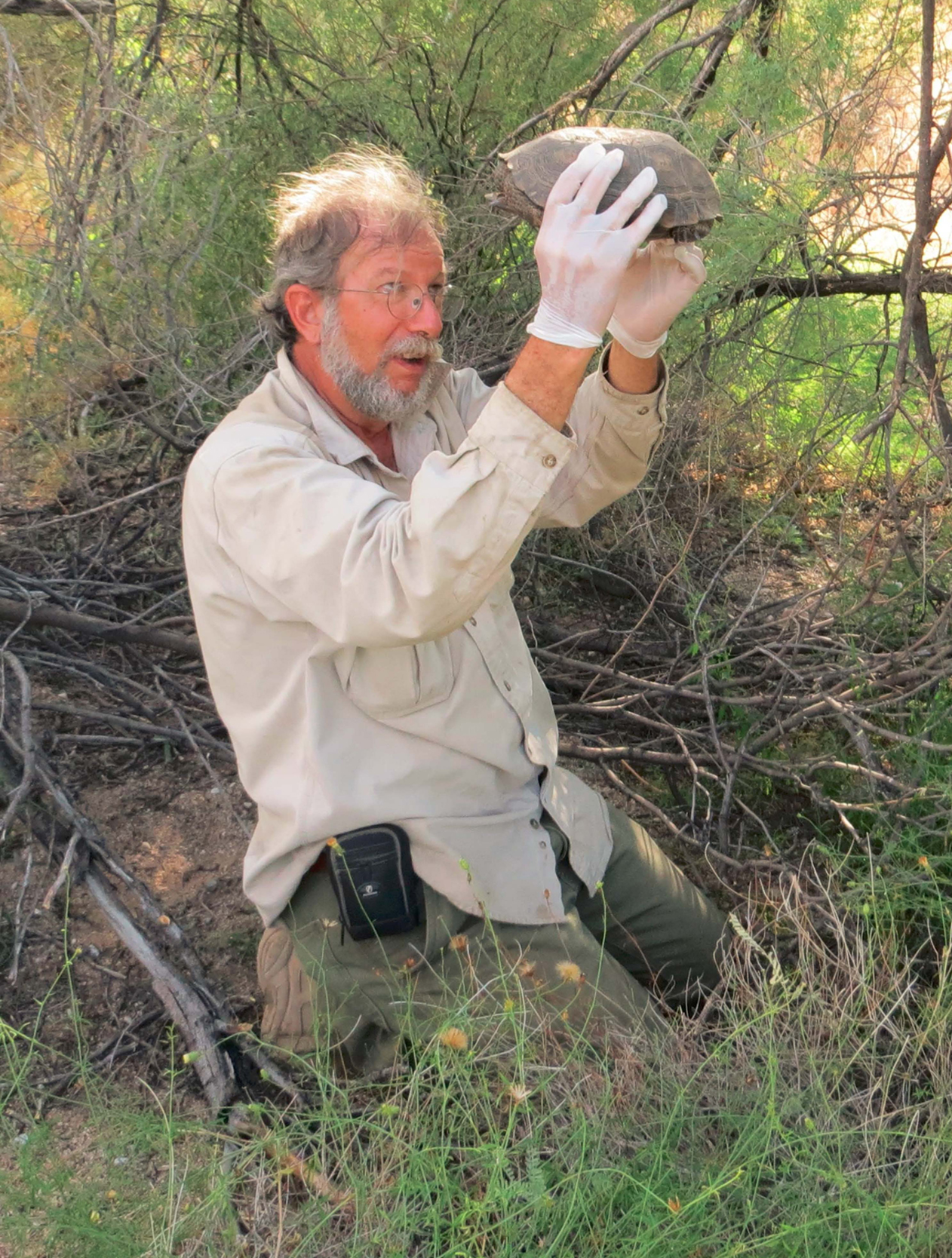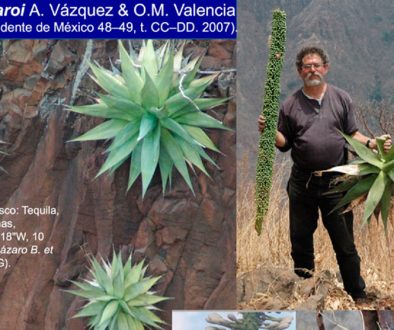Rafael Alejandro Lara-Resendiz
Consejo Nacional de Investigaciones Científicas y Técnicas (CONICET), Instituto de Diversidad y Ecología Animal (IDEA), Córdoba, Argentina
Universidad Nacional de Córdoba, Facultad de Ciencias Exactas, Físicas y Naturales, Centro de Zoología Aplicada, Córdoba, Argentina
rafas.lara@gmail.com
Received: 4 December 2020; accepted: 10 February 2021a
Philip Clark Rosen was born in New York City, USA, on February 25, 1955. “Phil” as he was known by many who knew him best, was a leading herpetologist and ecologist in the Sonoran desert region.
Phil C. Rosen was born into a family of naturalists, where his father Donn Eric Rosen (1929-1986) served as Director of Ichthyology at the American Museum of Natural History (AMNH) between 1961 and 1985, and his mother Carmela Berritto Rosen published a paper on Caribbean snails with eminent evolutionist Ernst Mayr in 1956. Therefore, Phil’s childhood occurred in the corridors of one of the 5 largest and oldest paleontology museums in the world. During his father’s tenure at the AMNH, the fish collection grew from 500,000 to 1,500,000 specimens. This prompted Phil to develop a deep love for biology when young. Phil would accompany his father to Central America, learning about field and museum work from an early age and sending herpetological material to the AMNH; and it served to learn a little Spanish too.
He completed degrees at the University of Michigan (B.Sc. 1980), Arizona State University, Tempe (M.Sc. 1987), and University of Arizona, Tucson (Ph.D. 2000), where he was a research scientist (2001-2020). The master’s work was carried out under the mentorship of James Collins with a study titled: “Life history and ecology of mud turtles (Kinosternon) in Arizona”. His Ph.D. advisor was an eminent biologist Charles H. Lowe (1920-2002), who was a doctoral student of Raymond B. Cowles (1896-1975); both were prominent researchers with great contributions that are considered classics in the ecology and physiology of desert species. Phil’s doctoral study was titled: “A monitoring study of vertebrate community ecology in the northern Sonoran Desert, Arizona”; a gigantic 307 page thesis, which synthesizes an 11-year monitoring (1987-1998) in Organ Pipe Cactus National Monument (ORPI) and analyzes the relationship between the abundance of the different groups in dry and rainy periods. Phil Rosen was Lowe’s last doctoral student, from whom he had a great influence, friendship, and fruitful collaboration.
Alternately to his graduate studies, Phil participated in numerous projects focused on amphibians and reptiles from deserts, grasslands, aquatic, and urban environments in the southwestern United States and northwest Mexico. He produced 50 formal research reports and over 70 publications, leaving many unpublished. His research involved conservation biology, working with ranid frogs, chelonians, and desert lizards. Among Phil’s first papers were reporting on the reproduction of aquatic turtles with Justin D. Congdon and Donald W. Tinkle (1981-1982). In the late 1980’s he began to publish studies on the Sonoran Desert herpetofauna. The 1990s were very productive with joint publications with Lowe, Cecil R. Schwalbe, Peter A. Holm, Shawn S. Sartorius, and others. One of his most cited articles is “Highway mortality of snakes in the Sonoran Desert of southern Arizona” published with Lowe in 1994.
Early on, his publications reflected an interest in the monitoring protocols of herpetofauna, invasive species and their effect on native fauna, as well as on the ecology and life history of numerous aquatic and terrestrial taxa. Between 2000 and 2020, he published primarily as a herpetologist, with at least 47 papers and scientific notes on the herpetofauna in the Sonoran Desert region, including some accounts in the Catalogue of American Amphibians and Reptiles (Sonora genus). His contributions in this period were coauthored mainly with George A. Bradley, Robert L. Bezy, Erik F. Enderson, Stephen R. Goldberg, and A. Quijada-Mascareñas. In 2007 he published a monumental work “The amphibians and reptiles of the dry borderlands of northwestern Sonora and southwestern Arizona”, an analysis and summary of the herpetofauna in this border area. Since this work, he published other papers and reports on the herpetofauna of northern Mexico, including Sonora, Chihuahua, and Sinaloa.
I met Phil in 2012 at Álamos, Sonora, when he led a project to research the desert tortoise, Gopherus, in Sonora and Sinaloa, Mexico. During 3 consecutive years, Phil and a group of Mexican students, “rancheros”, and locals monitored G. morafkai, the Sonoran desert tortoise, and G. evgoodei, the tropical deciduous forest tortoise, a species recently described by several colleagues including Phil. During that project (2012-2014) there were other priority chelonians of the genera Kinosternon, Terrapene, Rhinoclemys, and Trachemys. Phil had an incredible nose for locating turtle populations and made it clear that he was an expert at trapping aquatic turtles. Within 12 hours we had more turtles than we knew how to handle. At that time, I was a Ph.D. student at Instituto de Biología (UNAM) and personally, it was a great opportunity to get to know the Sonoran desert and its herpetofauna; and I managed to consolidate several collaborations with him. In 2014, at the Desert Tortoise Council Symposium in Ontario, California, Phil gave a lecture with all the information and results that had been collected for Gopherus in Mexico.
I knew that Phil had studied the thermal biology of several species of snakes of the genus Thamnophis (1991), so we returned to this topic and published 5 papers on the thermal ecology of some lizards and tortoises from the Sonoran and Chihuahuan deserts between 2014 y 2018. In this collaboration, we took a novel approach to combine the thermal ecology and mechanistic models to predict how global warming affects these ectotherms. Our work took us right to the US-Mexico border. He liked to camp and herp in this border region, especially in remote or prohibited places within the national parks, where more than once we had some picturesque/typical encounters related to illicit traffic, and human migration. In 2016 we recorded the first Coniophanes lateritius for the state of Sonora (a northern range extension of 423 km) during the inaugural bioblitz for Rancho San Pablo, located in the Reserva Monte Mojino, within the Reserva de la Biosfera Sierra de Álamos-Río Cuchuhaqui. This ranch was purchased from funds raised by auctioning the naming rights for G. evgoodei at the Turtle Conservancy’s Turtle Ball in Manhattan; a species that Phil co-authored.
In this era of climate change, one of his last coauthored and meaningful publications was a novel long-term study of 25 years, about how climatic variation influences the abundance of 5 lizard species in 32 sites in the Sonoran Desert. They found a general pattern of decreased precipitation and increased temperature across time and concluded that abundances of all species declined with rising daily minimum temperatures, suggesting degradation of cool refuge, having major impacts on lizard communities. He has ~ 60 abstracts, posters, and presentations at restoration meetings, herpetology symposia, and in national parks, primarily in Arizona and adjacent states.
Other relevant research topics he conducted were on the effects of the fungus Batrachochytrium dendrobatidis and alien species on various species of amphibians. He was an expert consulted in evaluating K. sonoriense and G. evgoodei for the IUCN. Phil also became involved with the first bullfrog technical report for Mexico’s National Biodiversity Commission (Conabio, 2009). His bibliography contains evidence of his success as a scientist and collaborator in diverse fields of inquiry. In 2003, the Tucson Herpetological Society (THS) awarded him the Jarchow Conservation Award for his contributions and superior work in herpetology and conservation in the region. In 2019, he had 2 keynote talks planned in Mexico, the first for the biology congress at the University of Sonora (UNISON) and the second at the congress of the Association for Research and Conservation of Amphibians and Reptiles (AICAR), however, his health problems began and he had to cancel his participation in both events. Phil spent his last years in a tailspin attributed to the unfortunate passing of his only child Jazmin, however he was supported tremendously by his wife Julia Rosen. Phil died in Tucson, Arizona on September 18, 2020 at the age of 65 after a brave battle with cancer. In homage to his dedication and fruitful career as a researcher, THS created a fund to digitize and preserve his field notes and data.
Those of us who knew him are grateful for his teachings and acknowledge his tremendous contributions to herpetology and the ecology of the Sonoran Desert region. He certainly leaves a huge void in this part of the world, but he also leaves a huge legacy to his successors. I thank Robert A. Villa for their help and review. I assume responsibility for any error, judgment, omission or interpretation.




